One Hundred and One Dalmatians
8.6 /10 1 Votes
98% Rotten Tomatoes Genre Animation, Adventure, Comedy Duration Language English | 7.2/10 IMDb Country United StatesUnited Kingdom | |||||||||||||||||||||||||||||||||
 | ||||||||||||||||||||||||||||||||||
Director Clyde GeronimiHamilton LuskeWolfgang Reitherman Release date January 25, 1961 (1961-01-25) Cast (Pongo), J. Pat O'Malley (Colonel / Jasper), (Cruella De Vil / Miss Birdwell), (Nanny / Queenie / Lucy), (Roger), Cate Bauer (Perdita)Characters Cruella de Vil (Betty Lou Gerson), Pongo (Rod Taylor), Sgt Tibbs (David Frankham), Anita Radcliffe (Lisa Davis), Perdita (Cate Bauer) Similar movies Tagline The Canine Caper of the Century | ||||||||||||||||||||||||||||||||||
101 dalmatians 1961 thunderbolt scene english
One Hundred and One Dalmatians, often abbreviated as 101 Dalmatians, is a 1961 American animated adventure film produced by Walt Disney and based on the 1956 novel The Hundred and One Dalmatians by Dodie Smith. The 17th Disney animated feature film, the film tells the story of a litter of dalmatian puppies who are kidnapped by the villainous Cruella de Vil (Betty Lou Gerson), who wants to use their fur to make into coats. Their parents, Pongo and Perdita, (Rod Taylor and Cate Bauer respectively) set out to save their children from Cruella, all the while rescuing 84 additional puppies that were bought in pet shops, bringing the total of dalmatians to 101.
Contents
- 101 dalmatians 1961 thunderbolt scene english
- Plot
- Story development
- Art direction
- Live action reference
- Character animation
- Casting
- Music
- Release
- Home video
- Box office
- Critical reaction
- Remake
- TV series
- Sequel
- Live action spin off
- References
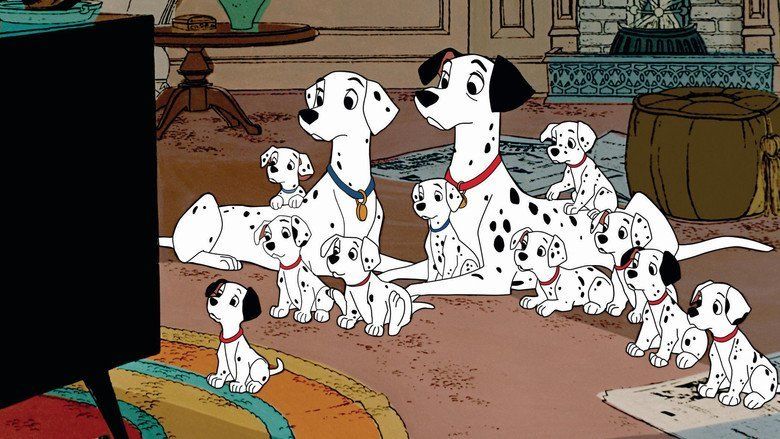
Originally released to theaters on January 25, 1961, by Buena Vista Distribution, One Hundred and One Dalmatians was a box office success, pulling the studio out of the financial slump caused by Sleeping Beauty, a costlier production released two years prior. Aside from its box office revenue, its commercial success was due to the employment of inexpensive animation techniques—such as using xerography during the process of inking and painting traditional animation cels—that kept production costs down. It was reissued to cinemas four times in 1969, 1979, 1985 and 1991. The 1991 reissue was the twentieth highest earning film of the year for domestic earnings. It was remade into a live action film in 1996.

Plot
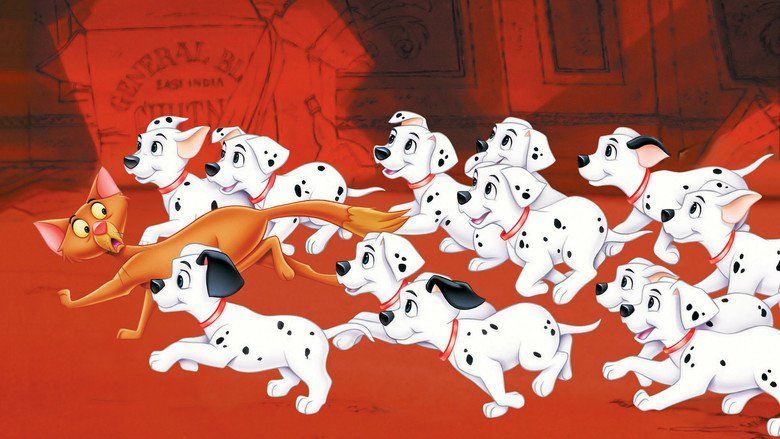
Songwriter Roger Radcliffe lives in a bachelor flat in London, along with his dalmatian, Pongo. Bored with bachelor life, Pongo decides to find a wife for Roger and a mate for himself. While watching various female dog-human pairs out the window, he spots the perfect one, a woman named Anita and her female dalmatian, Perdita. He quickly gets Roger out of the house and drags him through the park to arrange a meeting. He and Anita fall in love and get married.
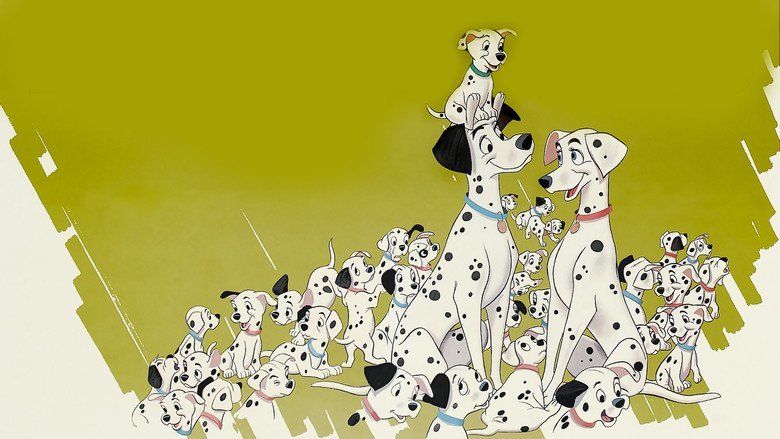
Later, Perdita gives birth to a litter of fifteen puppies. That same night, they are visited by Cruella De Vil, a wealthy former schoolmate of Anita's. She offers to buy the entire litter, but Roger says they are not for sale. A few weeks later, she hires her henchmen, Jasper and Horace, to steal them. When Scotland Yard is unable to find them, Pongo and Perdita use the "Twilight bark", a canine gossip line, to ask for help from the other dogs in London.
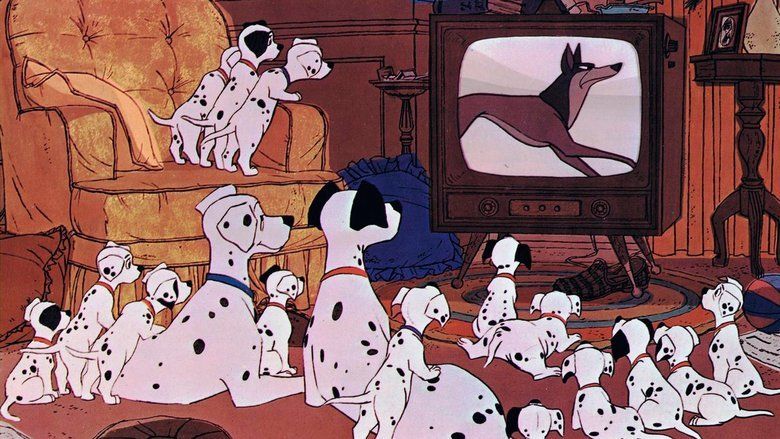
Colonel, an old sheepdog, along with his compatriots Captain, a gray horse, and Sergeant Tibbs, a tabby cat, find the puppies in a place called Hell Hall (Cruella's abandoned and dilapidated family estate, also known as The De Vil Place), along with many other dalmatian puppies that she had bought from various dog stores. When Tibbs learns they are going to be made into dog-skin fur coats, Colonel quickly sends word back to London. Upon receiving the message, Pongo and Perdita leave town to retrieve their puppies. Winter has come, and they have to cross the Stour River which is running fast and laden with slabs of broken ice. Meanwhile, Tibbs overhears Cruella ordering Jasper and Horace to kill the puppies that night out of fear the police will soon find them. In response, Tibbs attempts to rescue them while Jasper and Horace are preoccupied watching television, but they finish their show and come for them before he can get them out of the house. Pongo and Perdita break in and confront Jasper and Horace just as they are about to kill the puppies. While the adult dogs attack them, Colonel and Tibbs guide the puppies from the house.
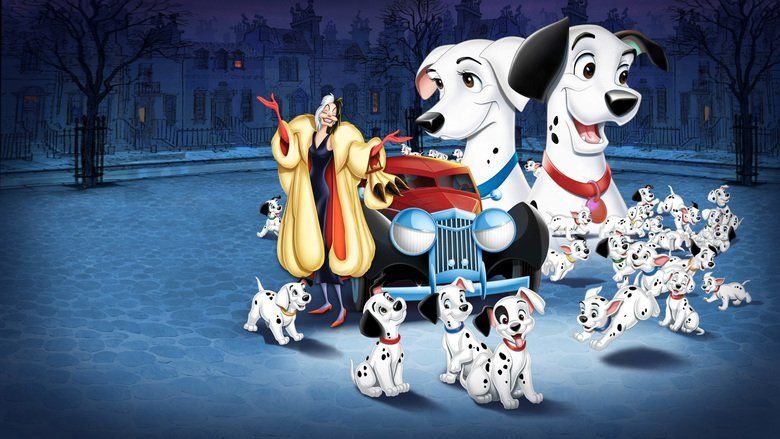
After a happy reunion with their own puppies, Pongo and Perdita realize there are dozens of others with them, 99 altogether including their own. Shocked at Cruella's plans, they decide to adopt all of them, certain that Roger and Anita would never reject them. They begin making their way back to London through deep snow; all open water is frozen solid. Other animals help them along the way. Cruella, Jasper, and Horace chase them. In one town, they cover themselves with soot so they appear to be labrador retrievers, then pile inside a moving van bound for London. As it is leaving, melting snow clears off the soot and Cruella sees them. In a rage, she follows the van in her car and rams it, but Jasper and Horace, who try to cut it off from above, end up crashing into her. Both vehicles are smashed to smithereens and fall into a deep ravine; and battered, bruised and stranded, Cruella and her henchmen are defeated at last. Cruella yells in frustration as the van drives away but Jasper finally gets the courage to tell her to shut up.
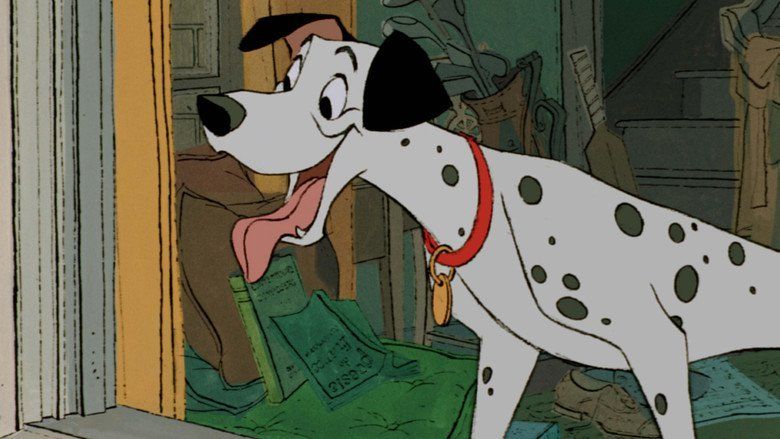
Back in London, Roger and Anita are attempting to celebrate Christmas and his first big hit, a song about Cruella, but they miss their canine friends. Suddenly, barking is heard outside and, after their nanny opens the door, the house is filled with dogs. After wiping away the rest of the soot, they are delighted to realize their companions have returned home. After counting 84 extra puppies, they decide to use the money from the song to buy a large house in the country so they can keep all 101 dalmatians.
Story development

Dodie Smith wrote the book The Hundred and One Dalmatians in 1956. When Walt Disney read it in 1957, it immediately grabbed his attention, and he promptly acquired the rights. Smith had always secretly hoped that Disney would make it into a film. Disney assigned Bill Peet to write the story, which he did, marking the first time that the story for a Disney animated film was written by a single person. Writing in his autobiography, Peet was tasked by Disney to write a detailed screenplay first before storyboarding. Because Peet never learned to use a typewriter, he wrote the initial draft by hand on large yellow tablets. He condensed elements of the original book while enlarging others, some of which included eliminating Cruella’s husband and cat, as well compressing the two surrogate mother dogs into one character, Perdita. He also retained a scene in which Pongo and Perdita exchange wedding vows in unison with their owners, by which the censor board warned that it might offend certain religious audiences if the animals repeated the exact words of a solemn religious ceremony. The scene was reworked to be less religious with Roger and Anita dressed in formal clothes.
Two months later, Peet completed the manuscript and had it typed it, in which Walt said the script was "great stuff" and commissioned him to begin storyboarding. Additionally, Peet was charged with the recording of the voice-over process. Although Disney had not been as involved in the production of the animated films as frequently as in previous years, nevertheless he was always present at story meetings. When Peet sent Dodie Smith some drawings of the characters, she wrote back saying that he had actually improved her story and that the designs looked better than the illustrations in the book.
Art direction
After Sleeping Beauty (1959) disappointed at the box-office, there was some talk of closing down the animation department at the Disney studio. During the production of it, Disney told animator Eric Larson: "I don't think we can continue, it's too expensive". Despite this, he still had deep feelings towards animation because he had built the company upon it.
Ub Iwerks, in charge of special processes at the studio, had been experimenting with Xerox photography to aid in animation. By 1959, he had modified a Xerox camera to transfer drawings by animators directly to animation cels, eliminating the inking process, thus saving time and money while preserving the spontaneity of the penciled elements. However, because of its limitations, the camera was unable to deviate from a black scratchy outline and lacked the fine lavish quality of hand inking. Disney would first use the Xerox process for a thorn forest in Sleeping Beauty, and the first production to make full use of the process was Goliath II. For One Hundred and One Dalmatians, one of the benefits of the process was that it was a great help towards animating the spotted dogs. According to Chuck Jones, Disney was able to complete the film for about half of what it would have cost if they had had to animate all the dogs and spots.
Ken Anderson proposed the use of the Xerox on Dalmatians to Walt, whom by then disenchanted with animation, replied "Ah, yeah, yeah, you can fool around all you want to." For the stylized art direction, Anderson took inspiration from British cartoonist Ronald Searle, whom once advised him to use a Mont Blanc pen and Indian ink for his artwork. In addition to the character animation, Anderson also sought to use Xerography on "the background painting because I was going to apply the same technique to the whole picture." Along with color stylist Walt Peregoy, the two had the line drawings be printed on a separate animation cel before being laid over the background, which gave the appearance similar to the Xeroxed animation. Disney disliked the artistic look of the film and felt he was losing the "fantasy" element of his animated films. In a meeting with Anderson and the animation staff concerning future films, Walt said, "We're never gonna have one of those goddamned things" referring to Dalmatians and its technique, and stated, "Ken's never going to be an art director again."
Ken Anderson took this to heart, but Walt eventually forgave him on his final trip to the studio in late 1966. As Anderson recalled in an interview:
He looked very sick, I said "Gee it's great to see you Walt", and he said "You know that thing you did on Dalmatians". He didn't say anything else, but he just gave me this look and I knew that all was forgiven and in his opinion maybe what I did on Dalmatians wasn't so bad. That was the last time I ever saw him. Then, a few weeks later, I learned he was gone.
Live-action reference
As with the previous Disney films, actors provided live-action reference in order to determine what would work before the animation process begun. Actress Helene Stanley performed the live-action reference for the character of Anita. She did the same work for the characters of Cinderella and Princess Aurora in Sleeping Beauty. Meanwhile, Mary Wickes provided the live-action reference for Cruella de Vil.
Character animation
Marc Davis was the sole animator on Cruella De Vil. During production, Davis claimed her character was partly inspired by Bette Davis (no relation), Rosalind Russell, and Tallulah Bankhead. He took further influence from her voice actress, Betty Lou Gerson, with whom he added her cheekbones to the character. He later complimented "[t]hat [her] voice was the greatest thing I've ever had a chance to work with. A voice like Betty Lou's gives you something to do. You get a performance going there, and if you don't take advantage of it, you're off your rocker." While her hair coloring originated from the illustrations in the novel, Davis found its disheveled style by looking "through old magazines for hairdos from 1940 till now." Her coat was exaggerated to match her over-sized personality, and the lining was red because "there's a devil image involved."
Casting
Before starring in high-profile roles such as The Birds and The Time Machine, Australian actor Rod Taylor had extensive radio experience, and was cast as Pongo. The filmmakers deliberately cast dogs with deeper voices than their human owners so they had more power. Walt Disney originally had Lisa Davis read for the role of Cruella De Vil, but she did not think that she was right for the part, and wanted to try reading the role of Anita. Disney agreed with her after the two of them read the script for a second time.
Betty Lou Gerson, who was previously the narrator for Cinderella, auditioned for the role of Cruella De Vil in front of Marc Davis and sequence director Wolfgang Reitherman, and landed it. While searching for the right accent of the character, Gerson landed on a "phony theatrical voice, someone who's set sail from New York but hasn't quite reached England." During the recording process, she was thought to be imitating Talluhah Bankhead. However, Gerson disputed, "Well, I didn't intentionally imitate her...I was raised in Birmingham, Ala., and Tallulah was from Jasper, Ala. We both had phony English accents on top of our Southern accents and a great deal of flair. So our voices came out that way." In addition to voicing Mrs. Birdwell, Gerson finished recording in fourteen days.
Music
Unlike many Disney animated features, the film features only three songs, with just one, "Cruella De Vil", playing a big part in it. The other two are "Kanine Krunchies Jingle" (sung by Lucille Bliss, who voiced Anastasia Tremaine in Disney's 1950 film Cinderella), and "Dalmatian Plantation" in which only two lines are sung by Roger at its closure. Songwriter Mel Leven had, in fact, written several additional songs for it including "Don't Buy a Parrot from a Sailor", a cockney chant, meant to be sung by Jasper and Horace at the De Vil Mansion, and "March of the One Hundred and One", which the dogs were meant to sing after escaping Cruella by van. Different, longer versions of "Kanine Krunchies Jingle" and "Dalmatian Plantation" appear on the Disneyland Records read-along album based on the film.
Release
One Hundred and One Dalmatians was first released in theaters on January 25, 1961. The film was re-released theatrically in 1969, 1979, 1985, and 1991.
Home video
Τhe film was released on VHS on April 10, 1992, as part of the Walt Disney Classics video series. By June 1992, it had sold 11.1 million copies. At the time, it was the sixth best-selling video of all time. It was re-released on March 9, 1999, as part of the Walt Disney Masterpiece Collection video series. Due to technical issues, it was never released on Laserdisc and was delayed numerous times before its release on DVD. The film was re-released on VHS, and for the first time on DVD, on December 1999, as a Walt Disney Limited Issue for a limited sixty-day time period before going into moratorium. A two-disc Platinum Edition DVD was released on March 4, 2008. It was released on Blu-ray Disc in the United Kingdom on September 3, 2012. A Blu-ray Diamond Edition of it was released in North America on February 10, 2015.
Box office
On its initial release, the film grossed $6.2 million in domestic rentals. It was also the most popular film of the year in France, with admissions of 14,705,526. The film grossed $14 million during its initial run. The film was re-released in 1969, where it earned $15 million. In its 1979 theatrical re-release, it grossed $19 million, and in 1985, the film grossed $32 million. During its fourth re-release in 1991, it grossed $60.8 million. The film's total domestic lifetime gross is $145 million, and its total worldwide gross is $215 million. Adjusted for inflation, and incorporating subsequent releases, the film has a lifetime gross of $888,264,400.
Critical reaction
In its initial release, the film received critical acclaim from critics, many of whom hailed it as the studio's best release since Snow White and the Seven Dwarfs and the closest to a real "Disney" film in many years. Howard Thompson of The New York Times wrote, "While the story moves steadily toward a stark, melodramatic "chase" climax, it remains enclosed in a typical Disney frame of warm family love, human and canine." However, he later opined that the "[s]ongs are scarce, too. A few more would have braced the final starkness." Variety claimed that "While not as indelibly enchanting or inspired as some of the studio's most unforgettable animated endeavors, this is nonetheless a painstaking creative effort." Time praised the film as "the wittiest, most charming, least pretentious cartoon feature Walt Disney has ever made."
Contemporary reviews have remained positive. Reviewing the film during its 1991 re-release, Roger Ebert of the Chicago Sun-Times, while giving the film three stars out of four, asserted that "it's an uneven film, with moments of inspiration in a fairly conventional tale of kidnapping and rescue. This is not one of the great Disney classics - it's not in the same league with Snow White or Pinocchio - but it's passable fun, and will entertain its target family audiences." Chicago Tribune film critic Gene Siskel, in his 1991 review, also gave the film three stars out of four. Ralph Novak of People wrote "What it lacks in romantic extravagance and plush spectacle, this 1961 Disney film makes up for in quiet charm and subtlety. In fact, if any movie with dogs, cats and horses who talk can be said to belong in the realm of realistic drama, this is it." In 2011, Craig Berman of MSNBC ranked it and its 1996 remake as two of the worst children's films of all time saying, "The plot itself is a bit nutty. Making a coat out of dogs? Who does that? But worse than Cruella de Vil's fashion sense is the fact that your children will definitely start asking for a dalmatian of their own for their next birthday".
The review aggregator website Rotten Tomatoes reported the film received an approval rating of 98% based on 30 reviews with an average score of 7.7/10. The website's critical consensus reads, "With plenty of pooches and a memorable villain (Cruella De Vil), this is one of Disney's most enduring, entertaining animated films."
Remake
In the years since the original release of the film, Disney has taken the property in various directions. The earliest of these endeavors was the live-action remake, 101 Dalmatians (1996). Starring Glenn Close as Cruella De Vil, none of the animals talked in this version. Its success in theaters led to 102 Dalmatians, released on November 22, 2000.
TV series
After the first live-action version of the film, a cartoon called 101 Dalmatians: The Series was launched. The designs of the characters were stylized further to allow for economic animation and to appeal to contemporary trends.
Sequel
101 Dalmatians II: Patch's London Adventure, the official sequel to the original animated film, was released direct-to-video on January 21, 2003.
Live-action spin-off
Disney has announced that another live-action film is in development, but it will focus on the origin of Cruella de Vil. Emma Stone is set to play Cruella and Alex Timbers is in negotiations to direct the film.
References
One Hundred and One Dalmatians WikipediaOne Hundred and One Dalmatians IMDbOne Hundred and One Dalmatians Rotten TomatoesOne Hundred and One Dalmatians themoviedb.org
